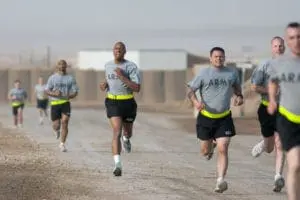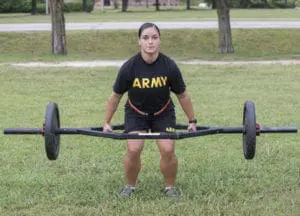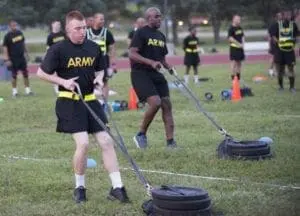
Photo c/o Wikimedia Commons
When you think about the Army Physical Fitness Test, you most likely picture three main components: push-ups, sit-ups, and running.
And that is for good reason. The test has been made up of these three core aspects for nearly four decades! However, after 38 years of the same Army PT test, some big changes are coming in 2020.
In this post, we discuss what you can expect from the new Army PT test and everything you need to know to ace it!
What is the new Army PT Test?
In July 2018, the Army announced plans to roll out a completely new PT test in 2020. This test will be both gender and age neutral and will be made up of six main challenges completed over 50 minutes, including:
- Deadlifts
- Standing power throw
- Hand-release push-ups
- Sprint-drag-carry
- Leg tuck
- Two-mile run
The service launched a 12-month field test of the new standards in October 2018. This study will help determine the best scoring standards to use. Once this initial testing is complete in October 2019, the Army will have one year to finalize and officially launch the new standards.
Why is there a new Army PT Test?
Many service members have asked why the Army decided to change its standard test after almost 40 years. And the answer is that there are several reasons.
The current PT test is estimated to be about 40 percent accurate when it comes to evaluating how effective a soldier will be in combat. And although 40 percent is better than nothing, the new test is thought to predict the effectiveness of a soldier with 80 percent accuracy.
One of the key reasons for this accuracy is that the new test evaluates candidates based on more than just muscular strength and cardiovascular endurance. Instead, it tests a wide range of fitness components including everything from muscular strength and endurance, to speed, agility, explosive power, balance, and flexibility. These new elements of the test simulate a variety of essential combat skills such as quick movement while under fire and loading heavy-duty weapons in the field.
What do I need to know about the new Army PT Test?
Now that you know a little bit more about the background and reasons for the new test, let’s get into the important stuff: What you need to know to pass it! In this section, we discuss each of the six elements of the test, and what you need to do to prepare effectively.
Deadlifts
Deadlifts entail lifting the max weight that you are able to do three consecutive times in five minutes. You will be required to lift somewhere between 120 and 420 pounds depending on certain factors.
As you practice for this section of the test, focus on figuring out the weight that allows you to perform the best, while also focusing on your form. It is essential to perform the action in one fluid motion, as improper form can lead to disqualification.
This segment of the test will be followed by a two-minute rest period before moving on to your next challenge . . .
Standing power throw
This element of the test involved a backward toss of a 10-pound medicine ball and measures how far you are able to throw it. The distance is measured in centimeters and must fall between 430 centimeters (or 14.5 feet) and 1400 centimeters (or 45.9 feet).
While training for this test, be sure to focus on controlled jumping because in the real test if you cross the line more than two times, you will be disqualified.
This portion of the test will also be followed by a two-minute rest before you head into . . .
Hand-release push-ups
A revamped version of the previous push-up segment, this new challenge measures how many push-ups a candidate can complete in three minutes. Unlike the traditional push-ups, you are most likely familiar with, these push-ups require lowering your body entirely to the ground and lifting up your hands in the share of a T between reps.
You guessed it! The push-up test is followed by another two-minute rest before the next segment . . .
Sprint-drag-carry
Similar to a shuttle run drill, this exercise tests your agility while dragging a heavy load. It involves doing the below tasks, over four minutes.
- Sprinting 25 meters and back without any weight
- Pulling a 100-pound sled 25 meters and back
- Sprinting 25 meters and back without a weight
- Running 25 meters and back with two forty-pound kettlebells
- Sprinting 25 meters and back to the start without a weight
Obviously, you are going to need that two-minute rest before tackling your next challenge . . .
Leg tuck
Perhaps the most dreaded segment of the new PT test, this drill involves hanging from a pull-up bar with an alternating grip and lifting your knees to your elbows. You will be required to do as many reps as you can in two minutes.
For maximum efficiency as you train, be sure to lean back while you are tucking your body so that you are parallel to the ground at the end of each rep. This will make it much easier to lift your knees completely to your elbows.
After this, you will be given a five-minute rest before undertaking the final element. . .
Two-mile run
Chances are that this portion of the test seems familiar. All candidates are required to complete two miles in 20 minutes or less. A two-mile run might not sound like much, but after completing all of the above challenges, you will be pretty physically exhausted by the time you get to the run. To ensure the best performance possible, be sure to use the five-minute break before your run to hydrate, breathe deeply, and stretch.
The takeaway
A new test means a new and exciting challenge, and it also means you need a new approach to training.
As you prepare for the new PT test we suggest focusing on three main areas covered by the test as you train: upper body strength, leg strength, and — of course — cardio. With plenty of training and practice, you will be ready when the test officially begins next year.
What are you most excited or frightened about in the new APFT? What do you think will be your biggest challenge? Leave a message in the comments!


